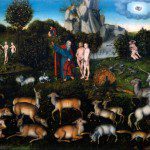 On many occasions I’ve been asked about details of evolution – a very complicated subject and one not directly in my line of expertise, although I am able to read much of the literature. The chief complaint is the lack of a good, trustworthy, resource presenting a simple (but not too simple) outline of evolutionary theory for the layman (or the pastor). Dennis Venema, Associate Professor of Biology at Trinity Western University in British Columbia and Senior Fellow at BioLogos, has also seen this need and is putting together a string of posts that provide an introduction to evolutionary biology. Dennis is a Christian – and a friend.
On many occasions I’ve been asked about details of evolution – a very complicated subject and one not directly in my line of expertise, although I am able to read much of the literature. The chief complaint is the lack of a good, trustworthy, resource presenting a simple (but not too simple) outline of evolutionary theory for the layman (or the pastor). Dennis Venema, Associate Professor of Biology at Trinity Western University in British Columbia and Senior Fellow at BioLogos, has also seen this need and is putting together a string of posts that provide an introduction to evolutionary biology. Dennis is a Christian – and a friend.
It is an overstatement to call this series of posts a MOOC – but it is a valuable resource nonetheless and I would like to give it a shout out here for those who may be interested.
From the blurb on his page Dennis’s research focuses “on the genetics of pattern formation and signaling, using the common fruit fly Drosophila melanogaster as a model organism. The superior genetic and molecular biology tools available in Drosophila make this organism second to none for developmental biology studies. Current projects include investigating the role of several cell-cell junction and cytoskeletal components during frizzled-independent tissue patterning of the pupal wing in flies.” Ok, this may seem a bit esoteric to many of us … but this kind of research, along with his teaching experience, give Dennis the expertise in genetics and evolution to write a useful introduction – Evolution Basics. Eight posts are available thus far, and more are planned. The topics include such important concepts as “Evolution as Scientific Theory“, “Variation, Artificial Selection and Natural Selection“, and the ever popular “Evolution and the Human Lineage“.
Consider the idea of Evolution as Scientific Theory:
In common English usage, “theory” means something like “guess” or “hunch”. It means something speculative, uncertain. In science, however, the meaning is almost exactly the opposite. In science, a theory is an idea that has stood the test of time. This difference between the common usage and the scientific usage of the word is a frequent source of confusion for nonscientists. In science, a theory is a well-tested idea – an explanatory framework that makes sense of the current facts available, and continues to make accurate predictions about the natural world.
Theories get their start as merely an idea, or hypothesis (plural = hypotheses). This literally means “less than” (hypo) a theory (thesis)”, and the name is appropriate. What scientists call a hypothesis is basically what nonscientists call a “theory” in the common English sense we discussed above. It’s an idea that makes sense, and fits with what we already know, but as such does not yet have much (or even any) experimental support. Here is where science departs from other approaches to knowledge: the key feature that distinguishes science from other activities is hypothesis testing. Rather than merely entertain a hypothesis as an interesting idea, scientists use a hypothesis to make specific predictions about the natural world, and then test to see if these predictions can be supported with experimental evidence.
…
So, what does any of this have to do with evolution? Simply this: despite what many evangelical Christians have been told, evolution is a theory in the scientific sense. It started off as a hypothesis, and scientists have been trying to reject that hypothesis to no avail. In the present day evolution is an explanatory framework that has withstood 150 years of testing, and continues to make accurate predictions about the natural world. Like heliocentrism, our ideas about evolution have developed significantly since the 1850s.
Today the evidence for evolution can be represented as a tapestry of many different threads woven together (an analogy not original to me). There is evidence from paleontology, from comparative anatomy, from embryology, from genetics, from cellular biology. These threads all weave together to form a consistent picture of evolutionary change. Threads are constantly added and some are occasionally revised and removed. We don’t, by a long shot, understand all of the details of biology yet – there is redundancy, recruitment of building blocks to serve a variety of functions, and a systems level feedback – much of which we are only beginning to understand. While it is virtually certain that parts of our current understanding of evolutionary biology is wrong, it is exceedingly unlikely that corrections and developments will make plausible a young earth or special creation view of origins. Intelligent design is slightly different – while some proposals have not held up to scrutiny, we know so little about the origin of life that it is unwise to make any kind of firm pronouncement. Any statement about the presence or absence of design in the origin of life of necessity represents a philosophical position.
To say that evolution is “only” a theory and thus should be taken with a grain of salt – as so many evangelical critics are wont to do – is to misunderstand the scientific meaning of the word theory.
Artificial and Natural Selection in the Dog.  Dennis uses examples of artificial and natural selection in the domestication of dogs (a subspecies of the gray wolf) to illustrate some of the features of evolution. Artificial selection has been used for millenia to artificially select for traits and features. Nature provides variations – and humans have added some tendency for selection in the selective breeding of dogs for desired traits. The dachshund shown to the right (image from wikipedia) is the result of many generations of selective breeding taking available of natural variations.
Dennis uses examples of artificial and natural selection in the domestication of dogs (a subspecies of the gray wolf) to illustrate some of the features of evolution. Artificial selection has been used for millenia to artificially select for traits and features. Nature provides variations – and humans have added some tendency for selection in the selective breeding of dogs for desired traits. The dachshund shown to the right (image from wikipedia) is the result of many generations of selective breeding taking available of natural variations.
 The Canis lupus species also provides an example of natural selection for a trait that is separating the dog from the wolf. The dog has a new gene, a duplication of a gene for an amylase enzyme found in the pancreas and involved in starch metabolism. Dogs, Dennis tells us, have 2 to 15 copies of this gene. Wolves have but one copy. Apparently duplication of this gene is a “relatively” common occurrence (rare but non-negligible). Gene duplication is a potent pathway in evolution. In this case the dog, cavorting with humans, consumes a fair amount of starch. Thus there is a selective advantage for duplicate copies of the gene, and the production of more amylase enzyme. There is no selective pressure for preservation of multiple copies of this gene in wolves who eat but little starch – and they continue to possess but one copy.
The Canis lupus species also provides an example of natural selection for a trait that is separating the dog from the wolf. The dog has a new gene, a duplication of a gene for an amylase enzyme found in the pancreas and involved in starch metabolism. Dogs, Dennis tells us, have 2 to 15 copies of this gene. Wolves have but one copy. Apparently duplication of this gene is a “relatively” common occurrence (rare but non-negligible). Gene duplication is a potent pathway in evolution. In this case the dog, cavorting with humans, consumes a fair amount of starch. Thus there is a selective advantage for duplicate copies of the gene, and the production of more amylase enzyme. There is no selective pressure for preservation of multiple copies of this gene in wolves who eat but little starch – and they continue to possess but one copy.
Duplication of the gene for the production of the amylase protein also occurred in the human lineage – here however the duplication was followed (or accompanied) by a change that modified the function of one of the copies resulting in production of the amylase enzyme in the saliva as well as in the pancreas (where it is found in dogs). Far more detail can be found in Dennis’s posts (Natural Selection and the Human Lineage Part 1 for example) – and in the references provided there.
If you are interested in understanding more of evolutionary biology, and why the theory is so convincing, I recommend this series of posts on BioLogos. From time to time (including the post today) we can discuss some of the issues here as well.
What does it mean to say that an idea is a theory?
What is the opposite of theory?
What would is take to prove or disprove a theory?
If you wish to contact me directly you may do so at rjs4mail[at]att.net
If interested you can subscribe to a full text feed of my posts at Musings on Science and Theology.











